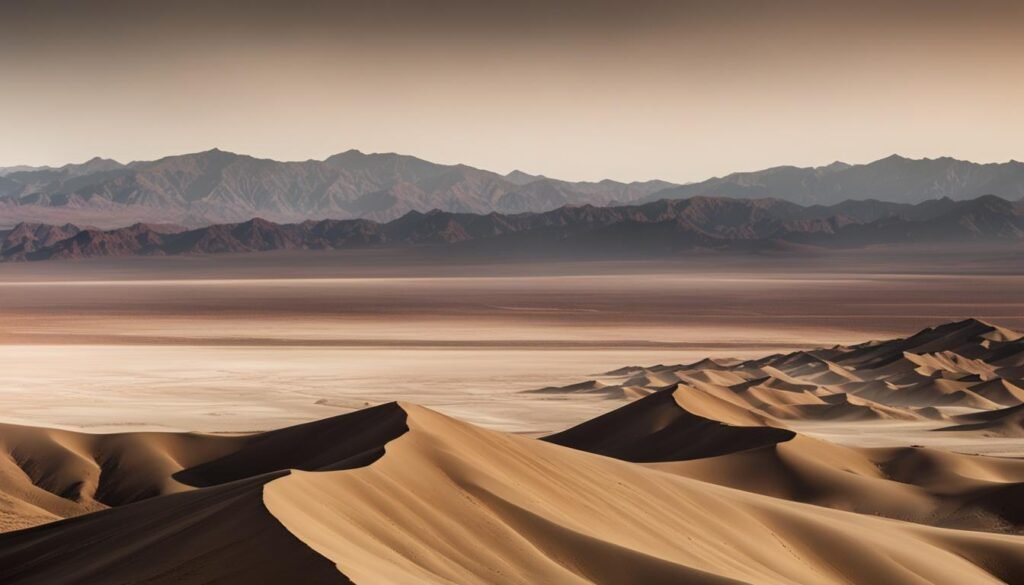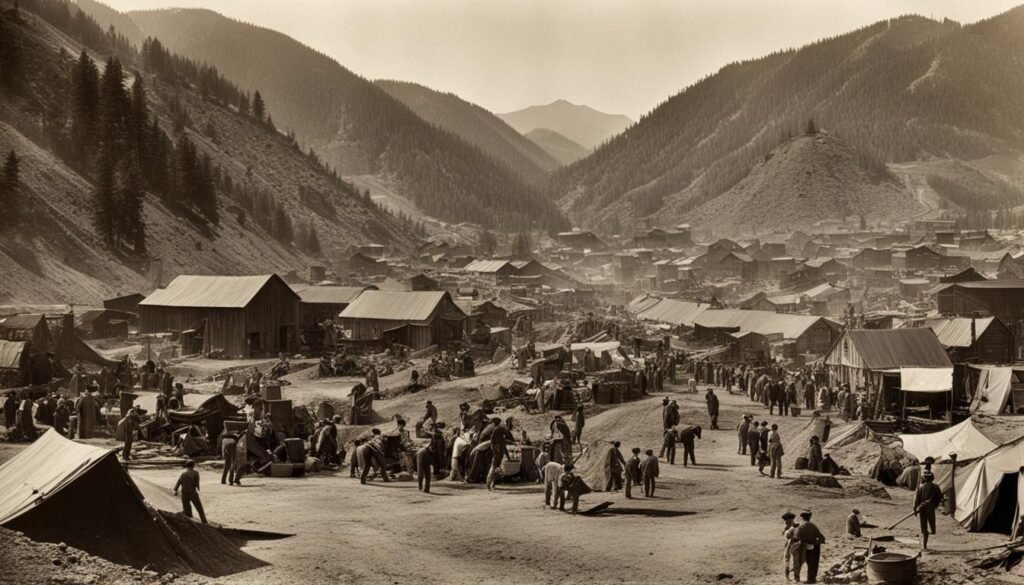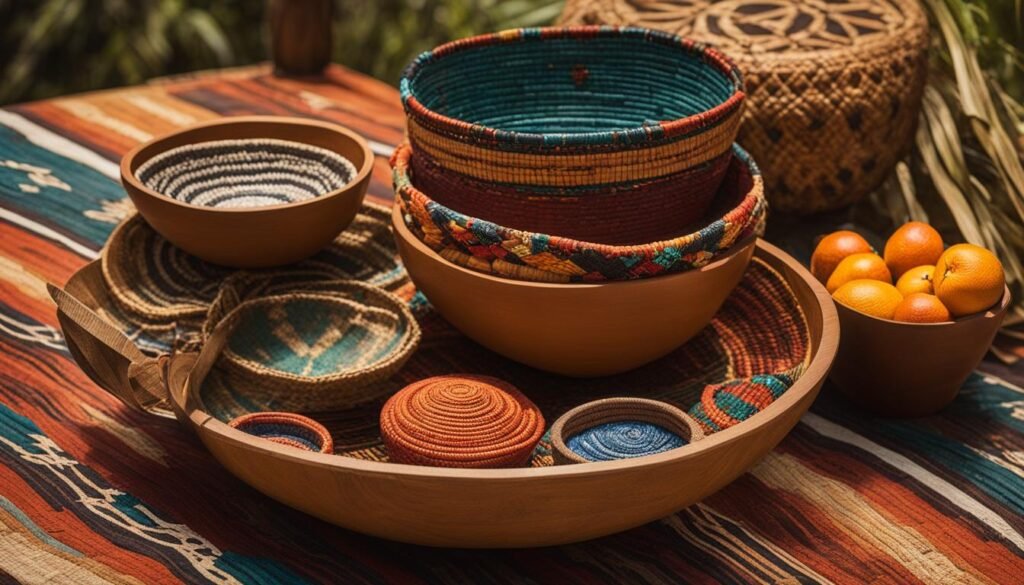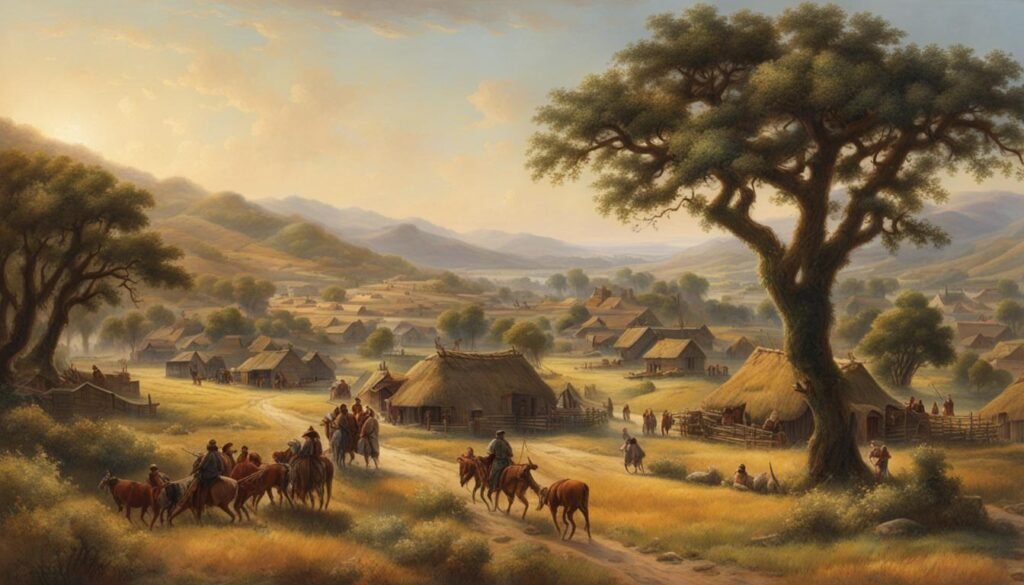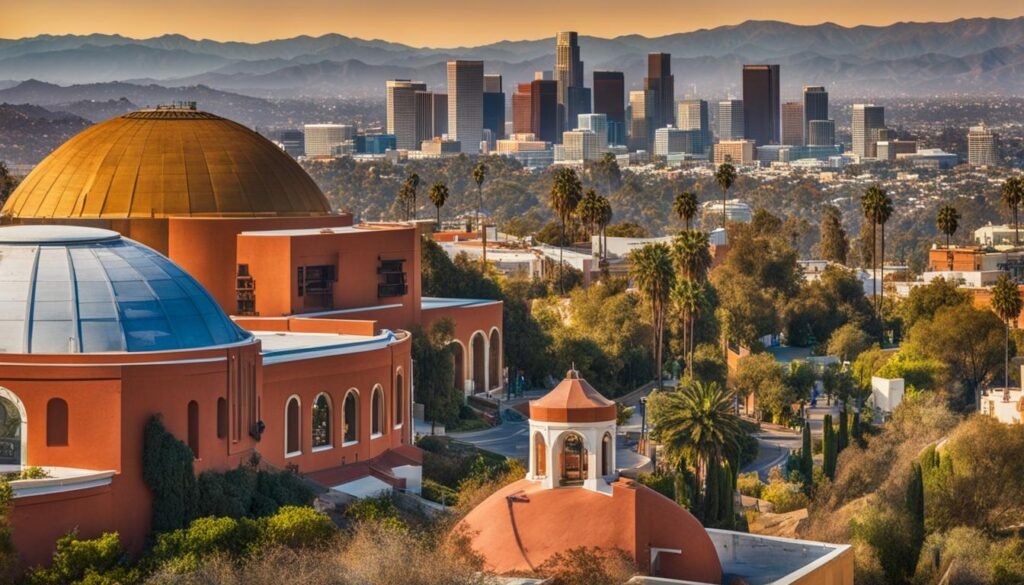Hey there! Are you curious to know where the Death Valley is located? Well, you’ve come to the right place. In this article, I will unravel the mystery of this intriguing desert valley in California.
The Death Valley is situated in Eastern California and is bordered by the Great Basin Desert. It is known for its extreme temperatures, making it the hottest place on Earth during the summer. So, if you’re thinking of visiting this unique destination, you better be prepared!
The valley covers an expansive area of 3,000 square miles and is nestled between the Amargosa Range and the Panamint Range. It is a part of the Death Valley National Park, which offers a plethora of attractions and activities for visitors to immerse themselves in.
Key Takeaways:
- Death Valley is located in Eastern California, bordering the Great Basin Desert.
- It is known for being the hottest place on Earth during the summer.
- The valley is part of the Death Valley National Park.
- It covers an area of 3,000 square miles and is surrounded by the Amargosa Range and the Panamint Range.
Death Valley National Park
When it comes to exploring the natural wonders of California, Death Valley National Park is a must-visit destination. This American national park is located east of the Sierra Nevada, straddling the California-Nevada border. Spanning over 3.4 million acres, it is the largest national park in the contiguous United States.
Death Valley National Park is renowned for its diverse and captivating environment. From expansive salt flats to towering sand dunes, picturesque canyons, and majestic mountains, the park offers a wide range of landscapes to discover and explore. The unique geology of the area has created breathtaking rock formations and colorful desert vistas that are sure to leave visitors in awe.
Aside from its stunning natural beauty, Death Valley National Park is known for its array of attractions and activities. Hiking enthusiasts can explore the park’s numerous trails, ranging from easy walks to challenging multi-day treks. Those looking for a thrill can try their hand at off-roading on the rugged backcountry roads or experience the adrenaline rush of sandboarding down the towering dunes.
Wildlife enthusiasts will also be delighted by the park’s diverse fauna and flora. Keep an eye out for desert bighorn sheep, coyotes, and the iconic Joshua trees that dot the landscape. Birdwatchers can spot various species of birds that call Death Valley their home.
Popular Attractions in Death Valley National Park:
- Badwater Basin: Explore the lowest point in North America, known for its vast salt flats.
- Mesquite Flat Sand Dunes: Take a walk on the stunning sand dunes, a photographer’s paradise.
- Zabriskie Point: Witness an otherworldly sunrise or sunset over the eroded badlands.
- Golden Canyon: Hike through beautiful narrow canyons, showcasing Death Valley’s geological wonders.
- Ubehebe Crater: Marvel at the massive volcanic crater, a testament to the valley’s tumultuous past.
With its awe-inspiring landscapes, rich biodiversity, and intriguing history, Death Valley National Park offers an unforgettable experience for nature lovers and adventure seekers alike. Whether you’re embarking on an epic hiking expedition, capturing stunning photographs, or simply immersing yourself in the park’s tranquility, a visit to Death Valley is sure to leave you with lasting memories.
Geography and Geology of Death Valley
Death Valley is a captivating region located in southeastern California, near the border of California and Nevada. Nestled within the vast Great Basin and Mojave Deserts, Death Valley occupies a unique position in the United States. Its precise coordinates are 36°14′49″N 116°49′01″W, marking its presence on the map.
The valley itself is formed as a graben, a down-dropped block of land, flanked by the imposing Amargosa Range to the east and the rugged Panamint Range to the west. This geographical arrangement creates a distinct and breathtaking landscape.
One of the striking features of Death Valley is its ancient geology. The rocks that make up this mesmerizing land date back over 1.7 billion years, preserving a remarkable record of Earth’s history. These ancient formations add an element of awe and wonder to the already mesmerizing scenery.
Within Death Valley, you’ll also find expansive salt pans that glimmer in the sunlight, a testament to the region’s unique ecosystem. These salt pans are remnants of Lake Manly, a vast inland lake that once existed during the Pleistocene era. Discovering the remnants of this ancient lake adds another layer of intrigue to the history of Death Valley.

Exploring the Geography and Geology
Engaging with the geography and geology of Death Valley is an experience like no other. It offers a rare opportunity to witness the incredible forces of nature that have shaped this enigmatic landscape. Marvel at the towering peaks of the Amargosa and Panamint Ranges, or venture into the vast salt pans to observe the unique ecosystem that thrives in these extreme conditions.
- Admire the breathtaking views from Zabriskie Point, a well-known lookout in Death Valley.
- Embark on a hike into Mosaic Canyon, where stunning rock formations captivate the eye.
- Witness the otherworldly beauty of the Racetrack Playa, where mysterious moving rocks leave trails behind them.
Exploring the geography and geology of Death Valley offers a deeper understanding of the immense power and beauty of the natural world. It is a journey that will leave you in awe of the forces that have shaped this remarkable desert valley.
Climate of Death Valley
When it comes to climate, Death Valley is known for its extreme conditions. This desert valley experiences a hot desert climate, with scorching summers and mild winters. As one of the hottest and driest places on Earth, Death Valley is not for the faint of heart.
In the summer, Death Valley sees temperatures that often exceed a blistering 120°F (49°C). In fact, it holds the record for the highest temperature ever recorded on Earth, a sweltering 134°F (56.7°C). Winter temperatures, on the other hand, rarely drop below freezing, but the nights can still be chilly.
When it comes to rainfall, Death Valley doesn’t see much. The average annual precipitation is a mere 2.36 inches (60 mm), making it a desert in every sense of the word. Most of the rainfall occurs during intense storms, which can lead to flash floods.
So, when is the best time to visit Death Valley? The answer lies in the spring or fall when the temperatures are milder. These seasons offer a more comfortable experience, allowing visitors to explore the stunning landscapes without battling extreme heat. Keep in mind that even during these months, you should still come prepared with plenty of water and sunscreen.
Wildlife and Natural Environment of Death Valley
Despite its extreme climate, Death Valley is home to a variety of plant and animal species that have adapted to its harsh environment. The valley is known for its unique flora and fauna, including the creosote bush, Joshua tree, desert bighorn sheep, coyotes, and the endangered Death Valley pupfish. More than 200 species of birds can also be found in the area.
The natural environment of Death Valley has been shaped by its geology, with vast salt pans, sand dunes, canyons, and mountains creating a diverse and interesting landscape for exploration.
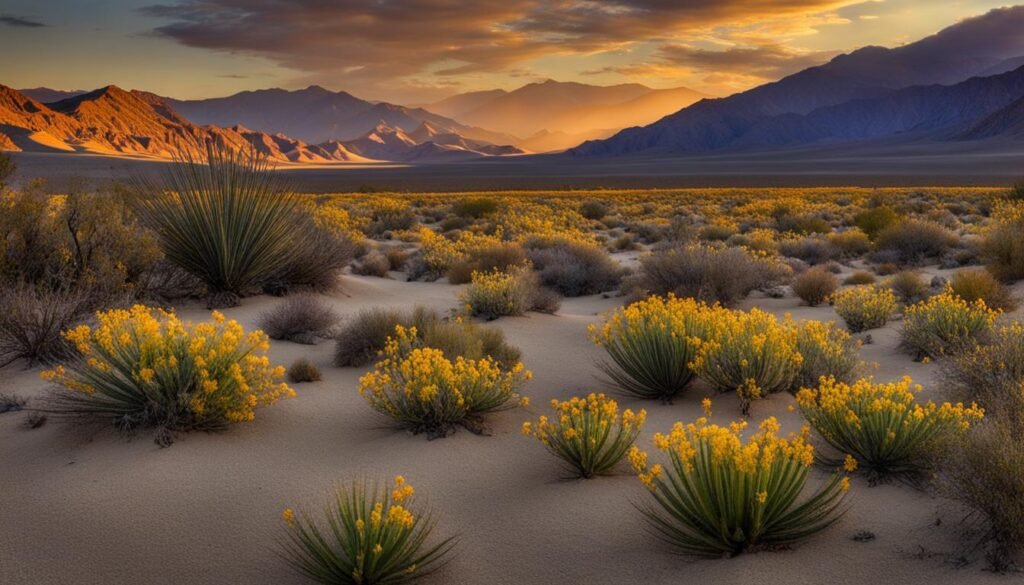
Exploring Death Valley allows visitors to witness the resilience and adaptability of the plant and animal life that thrives in this extreme desert environment. The creosote bush, with its small yellow flowers and aromatic scent, dominates the valley floor. Towering Joshua trees can be spotted throughout the park, standing as iconic symbols of the Mojave Desert.
Death Valley is also home to the elusive desert bighorn sheep, known for their impressive ability to navigate the rugged terrain. Coyotes, the clever predators of the desert, can be seen prowling the vast expanses in search of food.
One of the most fascinating species found in Death Valley is the endangered Death Valley pupfish. These small, silvery fish have adapted to survive in the extreme conditions of the saltwater springs and isolated pools scattered throughout the valley.
The birdlife in Death Valley is diverse and vibrant, with over 200 species inhabiting the area at different times of the year. Birdwatchers can catch glimpses of golden eagles, ravens, roadrunners, and various species of hummingbirds.
Exploring the Diverse Landscape
Death Valley’s natural environment offers a wide range of scenic landscapes to explore. The vast salt pans, such as the iconic Badwater Basin, create a mesmerizing expanse of white, stretching as far as the eye can see. The towering Mesquite Flat Sand Dunes provide the perfect setting for adventurous hikers and photographers to capture stunning desert vistas.
For those seeking a more challenging adventure, the canyons and mountains in Death Valley offer exhilarating hiking opportunities. Hiking through colorful canyons like Titus Canyon or exploring the rugged peaks of the Panamint Range provides a unique perspective of the valley’s geological wonders.
Exploration of Death Valley’s natural environment reveals the intricate balance between the harsh desert climate and the resilient flora and fauna that call this place home. It is a testament to the remarkable adaptability of life in even the harshest of environments.
Historical Significance and Tourism in Death Valley
When it comes to Death Valley, there is more to discover than just its extreme climate and unique natural environment. This desert valley holds a rich historical significance that dates back thousands of years. Evidence of Native American habitation can be found throughout the valley, showcasing the deep connection between these ancient civilizations and the land they called home.
In 1849, European Americans named the valley as they searched for a shortcut to the gold fields of California, forever etching its name in history. The late 19th and early 20th centuries saw several mining booms in the area, with borax becoming the most profitable ore. These mining ventures shaped the landscape and left behind remnants of an industry that once thrived in the harsh desert.
As the years went by, Death Valley transformed into a popular tourist destination. In the 1920s, resorts were built around Stovepipe Wells and Furnace Creek, attracting visitors from far and wide. Today, tourists flock to Death Valley National Park to explore its attractions, engage in outdoor activities, and immerse themselves in the valley’s captivating history and natural wonders.
Death Valley offers a wide range of activities for visitors to enjoy. From hiking through canyons to marveling at the breathtaking desert landscapes, there is something for everyone. Take a guided tour to learn about the valley’s history and geology, or embark on a scenic drive to witness the beauty of its vast salt pans and towering sand dunes. For those seeking a more adventurous experience, camping, stargazing, and off-roading are popular options to indulge in.
Whether you are looking to delve into the rich history of Death Valley, satisfy your sense of adventure, or simply admire the stunning natural scenery, this desert valley is a must-visit destination. With its diverse attractions and boundless opportunities, Death Valley is sure to leave you with memories that will last a lifetime.
Conclusion
Planning a visit to Death Valley is an exciting opportunity to explore and immerse yourself in the wonders of this unique desert valley. With its extreme climate, diverse wildlife, and captivating geological features, there is something for everyone to enjoy.
For those seeking adventure, Death Valley offers numerous hiking trails that lead through breathtaking canyons and stunning landscapes. The rugged beauty of the valley will surely leave you in awe and provide ample opportunities for exploration and discovery.
Additionally, history enthusiasts will appreciate the rich historical significance of Death Valley. From evidence of Native American habitation to the mining booms of the late 19th and early 20th centuries, there is no shortage of fascinating stories to uncover and learn about.
So pack your bags, prepare to be amazed, and embark on a memorable journey to Death Valley. Whether you’re looking to hike, photograph, or simply soak in the beauty of this national park, a visit to Death Valley promises to be an unforgettable experience filled with adventure, natural wonders, and awe-inspiring landscapes. Discover the magic of Death Valley and create memories that will last a lifetime.
FAQ
Where is Death Valley located?
Death Valley is located in Eastern California, bordering the Great Basin Desert. It is situated at coordinates 36°14′49″N 116°49′01″W.
Is Death Valley a desert?
Yes, Death Valley is a desert valley located in Eastern California.
What is the climate like in Death Valley?
Death Valley has a hot desert climate, with extremely hot summers and warm winters. Summer temperatures often exceed 120°F (49°C), and the highest temperature ever recorded was 134°F (56.7°C). Winter temperatures rarely fall below freezing.
What are some attractions in Death Valley National Park?
Death Valley National Park offers various attractions, including salt flats, sand dunes, canyons, and mountains. Visitors can explore places like Badwater Basin, Zabriskie Point, and Artist’s Drive.
What is the best time to visit Death Valley?
The best time to visit Death Valley is during the spring or fall when the temperatures are milder.
What kind of wildlife can be found in Death Valley?
Death Valley is home to a variety of wildlife, including the creosote bush, Joshua tree, desert bighorn sheep, coyotes, and the endangered Death Valley pupfish. More than 200 species of birds can also be found in the area.
What is the historical significance of Death Valley?
Death Valley has a rich historical significance, with evidence of Native American habitation dating back thousands of years. The area experienced several mining booms in the late 19th and early 20th centuries, and resorts were built in the 1920s. Today, visitors can learn about the valley’s history and natural wonders.

